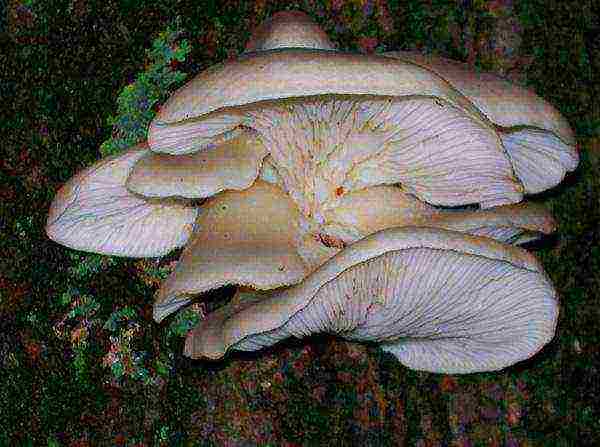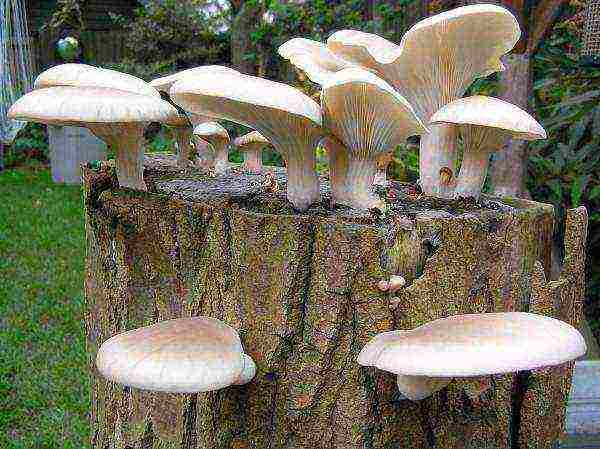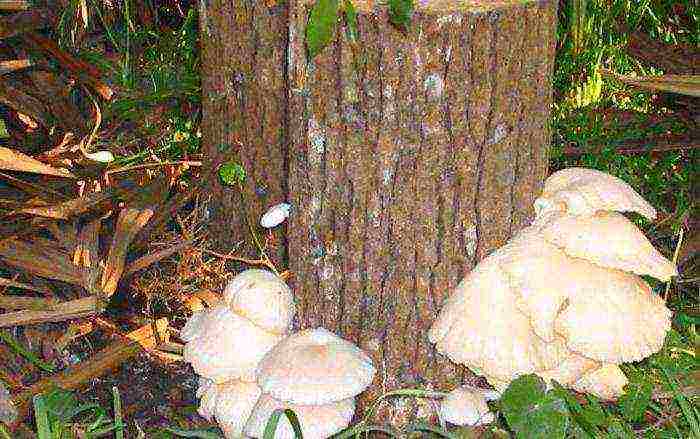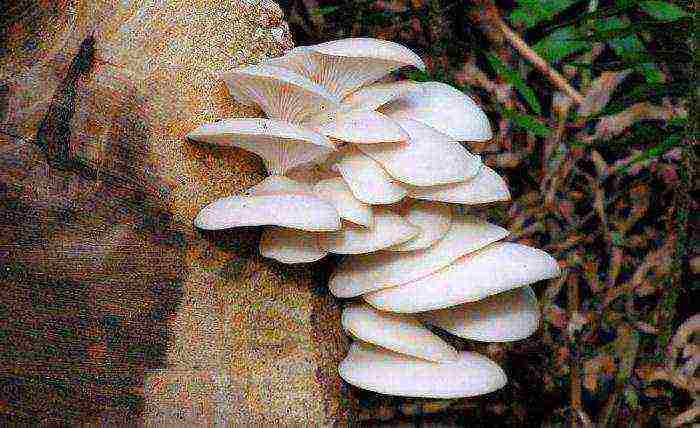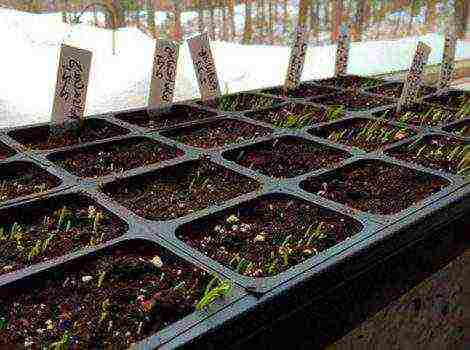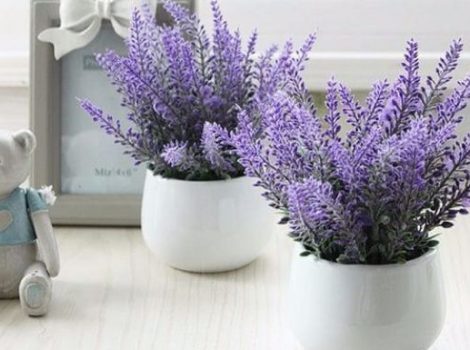Content
In recent years, more and more people have begun to master technologies that allow collecting oyster mushrooms on stumps. Growing these mushrooms at home does not require any special knowledge and skills. After reading this article, you will learn about the main stages of this process.
Mycelium selection
To collect oyster mushrooms on stumps, cultivation must begin with the acquisition of high-quality planting material. Some vendors offer to buy mycelium on sticks. However, long-term practice has shown that when using them, the first harvest can be obtained only after two years, and sometimes even later. Therefore, experts recommend purchasing fresh mycelium from oats or wheat. When choosing such planting material, you must make sure that there is no gray-green mold on it, the excess of which indicates the poor quality of the offered product.
When is it better to plant oyster mushrooms on stumps?
It is advisable to start growing these mushrooms in the autumn months. It is during this period that they do not require frequent watering, and the crop ripens much faster. If, with spring sowing, it will be possible to feast on mushrooms after a year and a half, then with autumn sowing - just a year later. In the first six months, oyster mushrooms require special care, which consists in frequent watering.
All of the above does not mean that you need to abandon the spring sowing of mycelium. It's just that in such cases, the logs with the future harvest are not buried in the ground, but placed in the basement and covered with wet burlap so that they gradually become overgrown with mycelium. In the fall, they are taken out of the cellar and buried in the ground.
Sowing technology
It should be understood that growing oyster mushrooms at home on stumps is a long and laborious process. In this case, you can only get a seasonal harvest, depending on climatic and weather conditions. The preparation of stumps must begin at the end of January. It is advisable to choose those on the surface of which there are no signs of mold. Before adding planting material, the logs should be soaked in water for three days. This will create the increased moisture required for the mycelium to be set. Stumps with mycelium can be taken out into the garden no earlier than May, when the threat of frost will completely disappear.
To get a good harvest of oyster mushrooms on stumps, cultivation and sowing can be carried out in several different ways:
- Holes are made in the logs, the depth of which is about six centimeters, and the diameter is about ten millimeters. Then they are filled with mycelium in grains and covered with moss or scotch tape.
- Planting material is laid out on the end of the stump and covered with a disc previously cut from a log, the thickness of which is about three centimeters, and then fixed with nails.
- A pyramid is built from the chocks, and the end of each log is covered with a two-centimeter layer of mycelium.
After sowing, the stumps are placed in a cellar and covered with burlap or foil.
Growing oyster mushrooms on stumps in the basement
In order for your venture to be crowned with success, it is necessary not only to choose the right mycelium, but also to create optimal conditions in the room chosen for these purposes. It is important that the air temperature in the basement is at least fifteen and no more than twenty degrees, and the humidity is within 80-95%.
It is recommended to pay special attention to ensuring good ventilation and lighting. It should also be understood that growing oyster mushrooms on stumps in the basement implies insulation and re-equipment of the room.To avoid carbon dioxide build-up, it is imperative to install fans. It is advisable to use fluorescent lamps as lighting devices. To place blocks with mushrooms in the basement, special racks should be equipped in advance. It is preferable that they are made of durable plastic that is resistant to moisture.
Open ground transplant
In May, hemp with oyster mushrooms can be moved to the garden. The readiness for landing on open ground can be judged by the presence of a dense white bloom. For the most successful fruiting of myceliums, it is advisable to put the logs in the shade, for example, under densely leafy trees.
Wet leaves are lined at the bottom of the pre-dug pits, and then stumps are planted. It is important that the embedment depth of the logs does not exceed fifteen centimeters. The distance between adjacent chocks should be about half a meter. Further care of the plantings consists in periodically moistening the soil around the logs. The first crop can be harvested at the beginning of autumn.
With the onset of winter, it is recommended to wrap hemp with spruce branches, leaves or straw. A similar mycelium will bear fruit abundantly for several years in a row. The maximum mushroom harvest can be harvested in the second and third years.
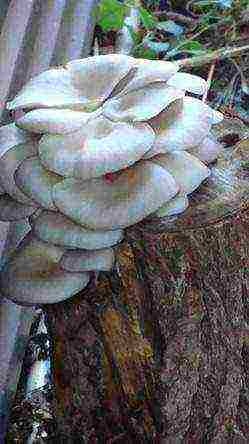
Today I want to show you how I grow mushrooms at home - oyster mushrooms.
It is very simple and not troublesome. Sow mycelium once and pick mushrooms for 3-5 years. With this method of cultivation, mushrooms turn out to be very fragrant - like grown in the forest and radically different in taste from store ones.
Each of you has the opportunity to grow eco-mushrooms in a garden plot on a stump.
I sowed mycelium for the first time 3 years ago - today is the fourth spring. This spring I decided to expand my plantations and at the same time tell everyone - because I am always asked a lot of questions.
Conifers are NOT SUITABLE for planting oyster mushrooms. The best for planting are deciduous trees: poplar, apple, cherry, oak, alder, beech, chestnut, ash, maple, poplar, birch, aspen, walnut.
Oyster mushroom grows especially well on walnut and poplar stumps.
The harder the wood, the longer the stump will last, and the more mushroom yields will grow on it.
The planting site for oyster mushrooms is a very important factor.
Oyster mushrooms do not really like places where the sun is too bright or a large open space. Therefore, it is better to plant oyster mushrooms under the trees in the garden. For example, oyster mushrooms grow well under a spreading walnut, well, or under other trees. Trees will shade the hemp with their crowns. Remember that the oyster mushroom planting site must be open to rainfall. This will save yourself the trouble of watering the mushroom garden.
You can use plots along the sheds and other structures on the north side.
Initially, I put stumps along the fence - between the building and the fence. There is a distance of about half a meter. It's enough. The main thing is not to put it under a canopy - so that the stumps are watered with rain.
To populate the mycelium, we need hardwood hemp - the size of the cuttings can be different - from 30 to 50 cm in length and 15 to 40 cm in diameter. The main thing is that the wood is healthy and there are no signs of mold infestation.
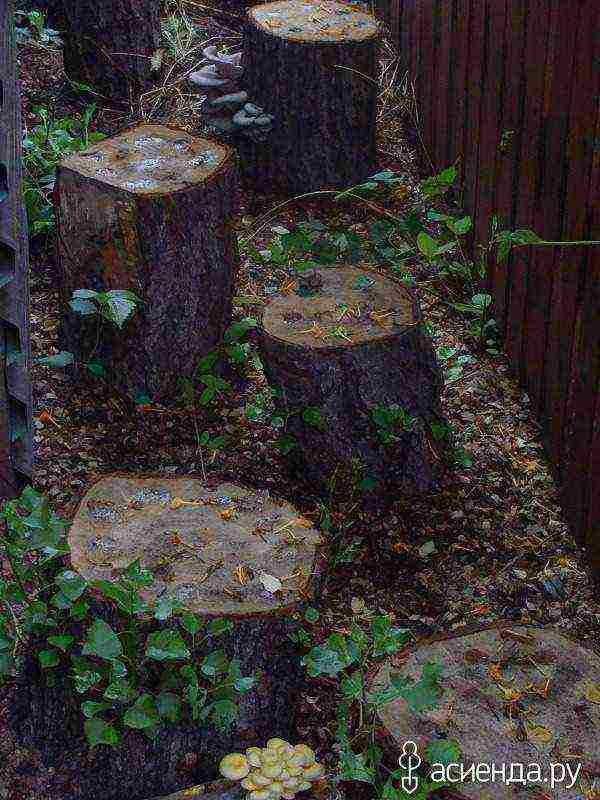
Prepare a tree stump for direct planting. It should be freshly cut, not old (dry). If the hemp is about a month old - place it in water for a day - so that it becomes wet. But, of course, it is better to use freshly sawn stumps for breeding oyster mushrooms. Then a successful result will be guaranteed.
We take the hemp, drill holes in them with a diameter of about 1-2 cm.It is possible smaller, but the smaller the diameter, the more difficult it is to fill the mycelium into it. Number in random order 6-8 holes on top and 4-6 holes on the side. IMPORTANT: The stump should stand vertically with its top up, that is, as a tree grew in nature, so put the stumps, do not change direction, turning the stumps upside down.
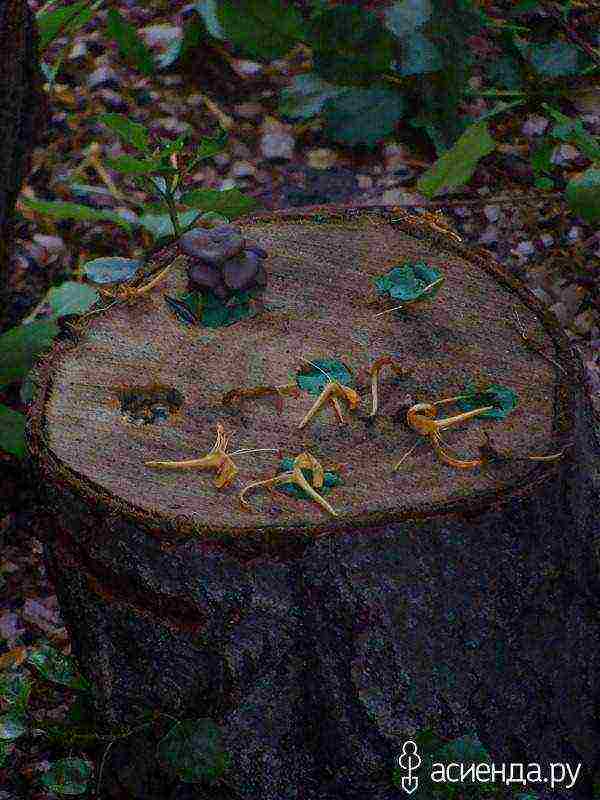
We fall asleep the mycelium. For convenience, we take a pencil (or other tamping device), put the mycelium into the holes, tamping it tightly with a pencil (stick, mortar, suitable in size) - do not worry, nothing will happen to the mycelium. The holes must be closed. You can close it in various ways - you can use plasticine, moss, duct tape, or, most conveniently, with a garden pitch. Some are even covered with cement. Mushrooms do not necessarily grow from these holes, they sprout inside the stump and come out anywhere
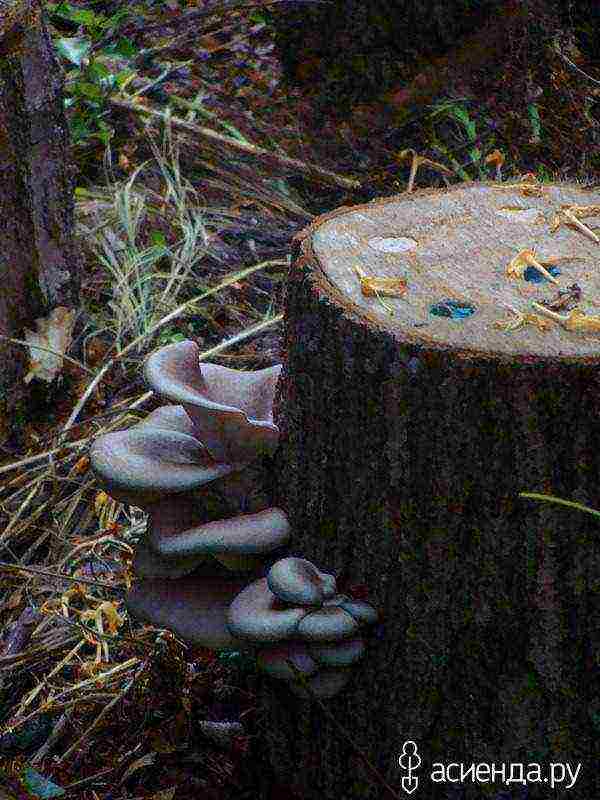
To install the stump, we dig a small hole - the depth is about 5 centimeters, put the stump in the holes and sprinkle the sides with earth. This is so that the stump is more stable and pulls moisture from the ground. Grass can grow around the stump. For more moisture, you can sprinkle around the mown grass, fallen leaves, etc., so that the soil remains moist longer.
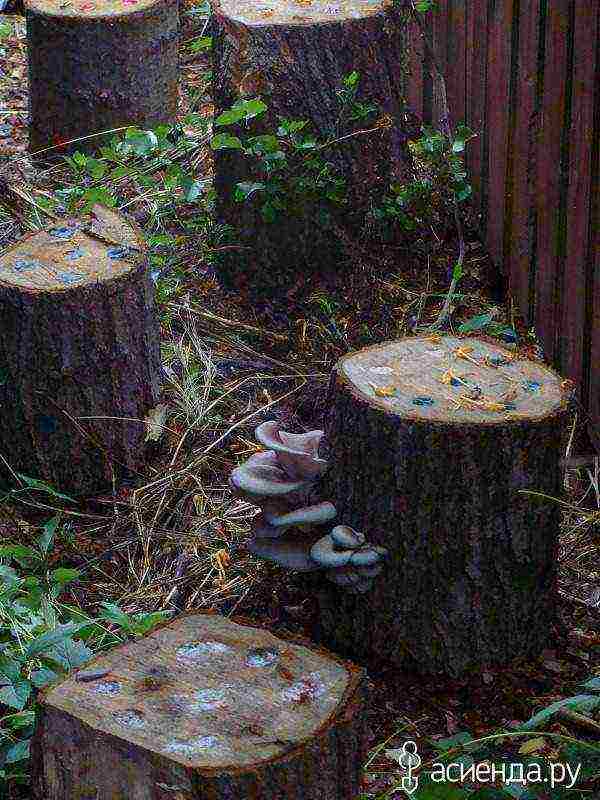
Planted, watered around and that's it. We are waiting for the harvest.
If the summer is dry, the stumps can be watered. But do not pour water directly on the stump, mycelium does not like direct ingress of water, only moisture. That is, you can water the stumps with a fine spray
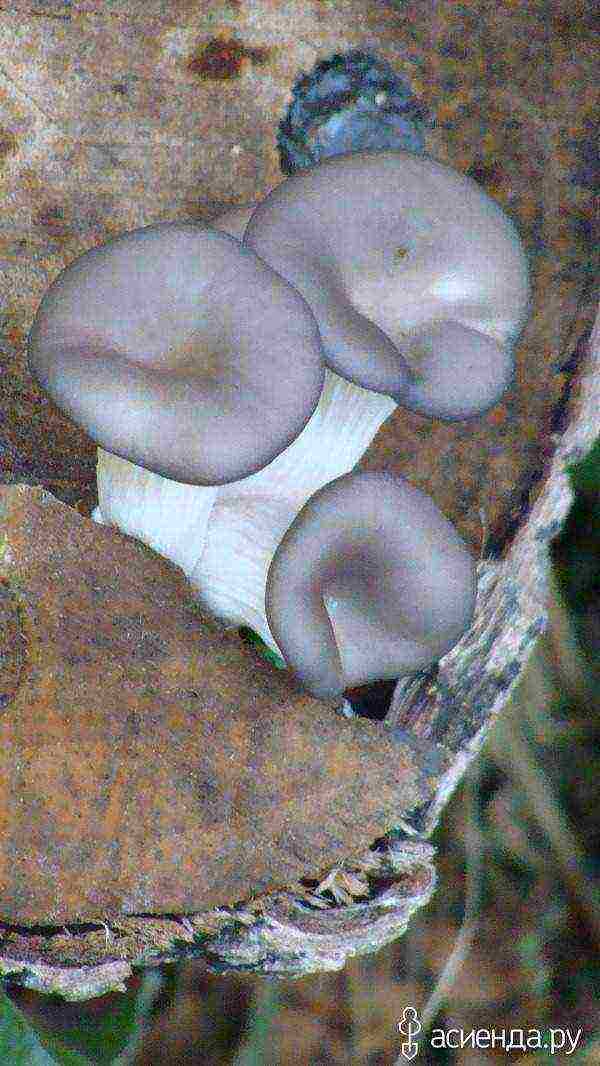
This year I decided to increase my mushroom plantation.
My husband just howled at my message that he needed to "prepare" the stumps again. By the way, it's not easy to drill them.
Buying mycelium in the society of mushroom growers, I got into conversation with their technologist (gored me with questions) and he suggested to me a less time-consuming way to populate hemp with mycelium.
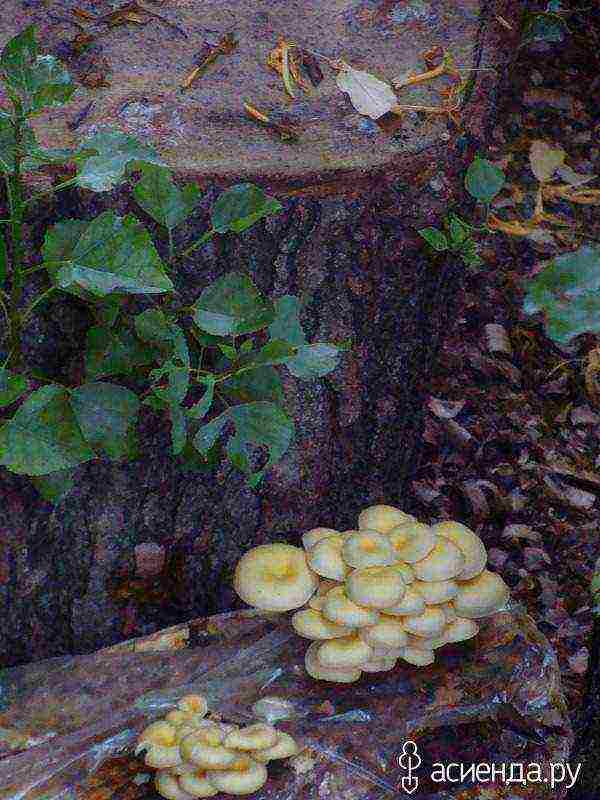
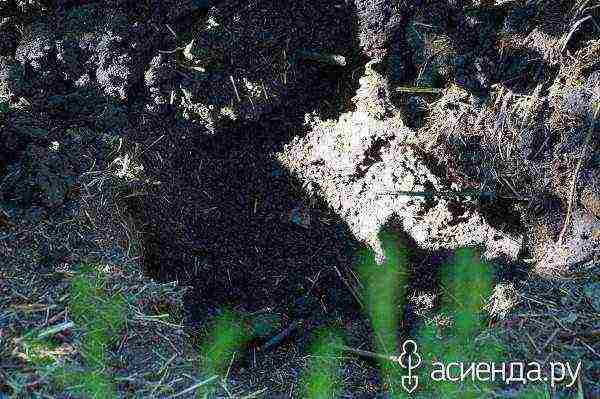
All ingenious is simple.
Digging a hole - a little less than a bayonet chipping - 15 centimeters, well 20.
The width is slightly wider than the harvested hemp.
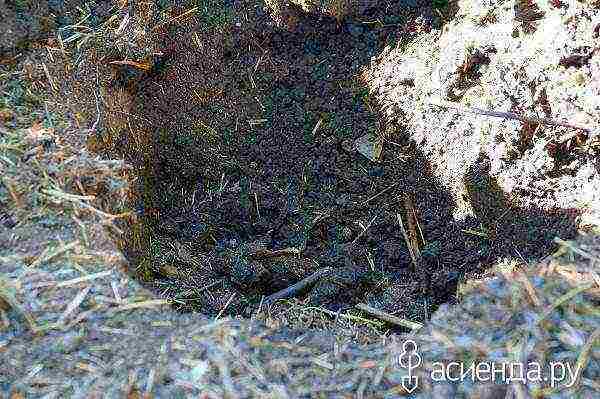
At the bottom we pour a pillow - 5 centimeters. It is possible a little more - not fundamentally.
This can be sunflower husks, dry moss, shavings or sawdust of deciduous trees.
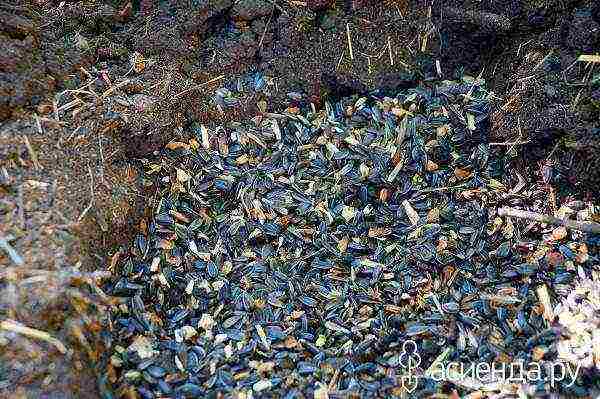
Water the hole with a pillow abundantly and pour mycelium on top - about 2 centimeters. About a handful of grain mycelium on a stump.
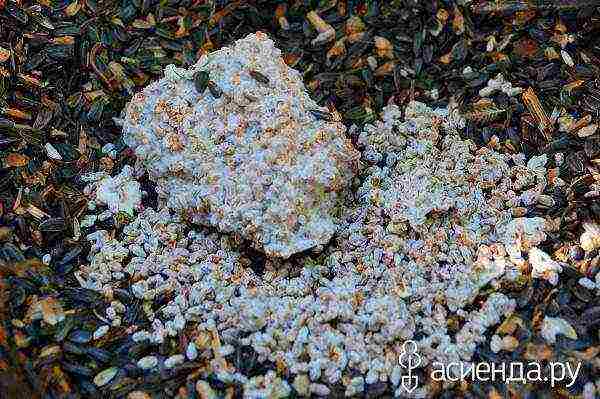
My mycelium is settled on a grain basis (wheat). I bought this mycelium from the mushroom growers' community in our city. A pack of mycelium - 2 kg costs 106 rubles today. This pack is enough for 5-6 hemp. You can search for mycelium online or search for a mushroom growing community in your area.
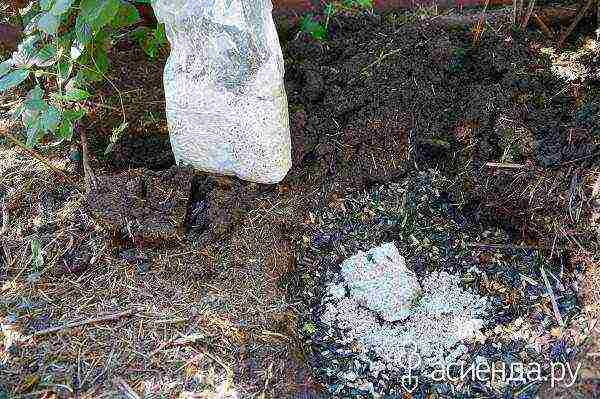
Prepared fossa
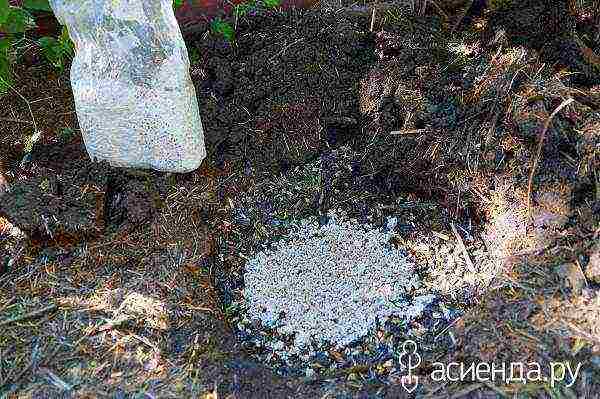
We put a stump on the mycelium.
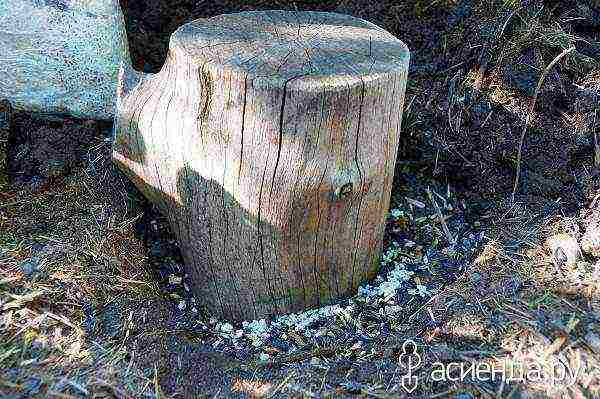
Sprinkle the sides with earth (no need to tamp) and water abundantly around.
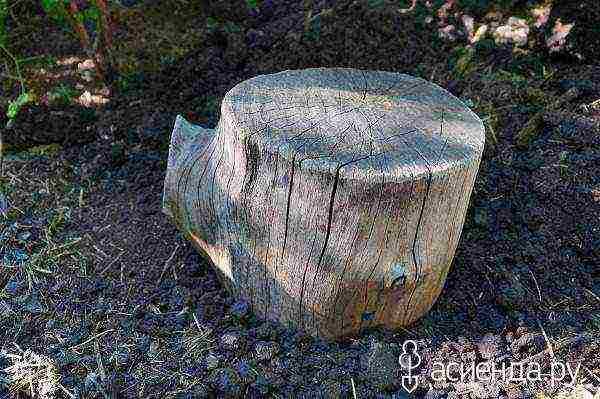
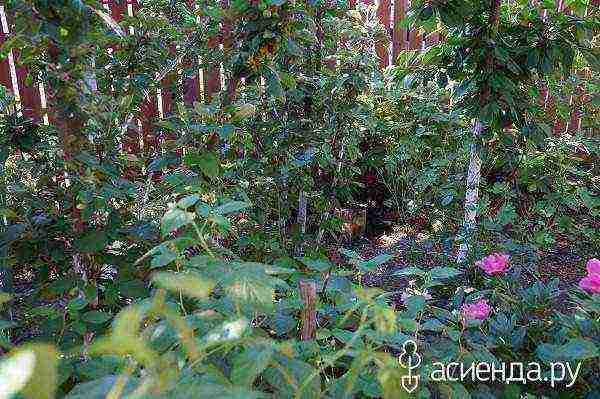
This is a general view of the place where I "planted" a stump this year - along the fence under the raspberry bushes, from above they give a shadow of the crown of large cherries.
A great place for stumps is under the spreading walnuts.
There is practically no need to look after your mushroom plantation.
Nature takes care of the good harvest itself. However, if the planting was done in the wrong place, for example, too sunny, periodic watering will be necessary.
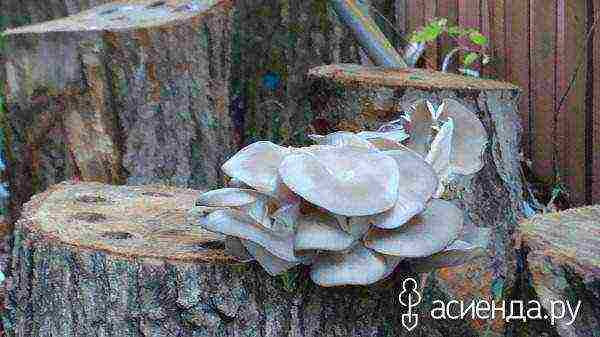
This method of growing oyster mushrooms will allow you to get a harvest of mushrooms in the same season. Moreover, you will receive mushrooms all year round - from the beginning of warm days to December (in the south, when there is no frost). Each stump will bear fruit until it completely disintegrates into parts. Such a mushroom plantation can feed you for 3-5 years, but the largest harvests occur in the second and third years. Mushrooms with 10 stumps are more than enough for one family - and we fry and pickle and preserve for the winter.
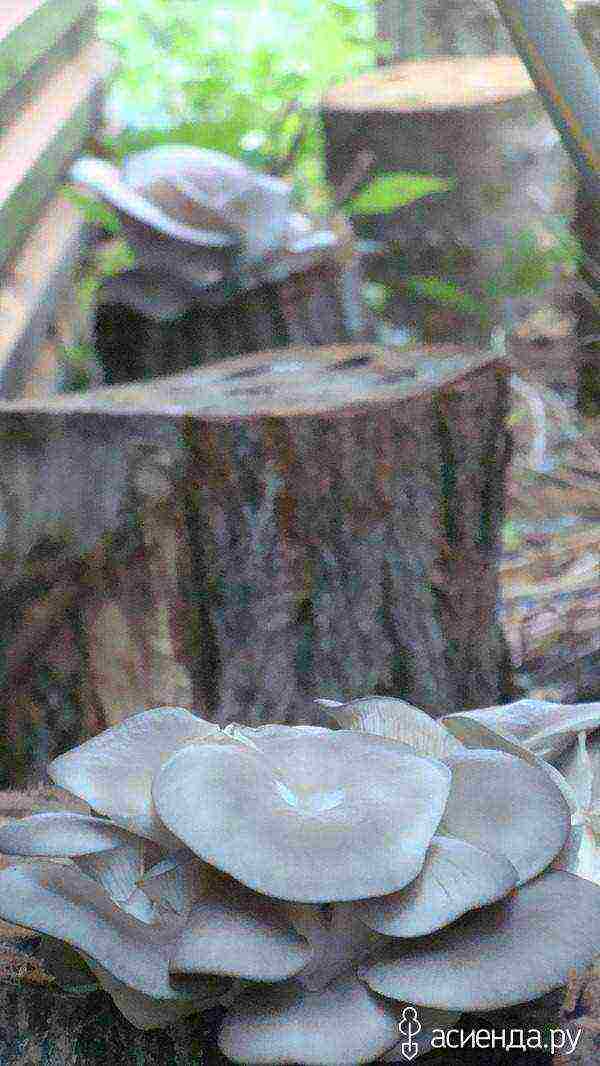
If stumps from felled trees remain on your site, you can use them, but they should be sown with mycelium only in April-May, when the temperature is above zero.
Oyster mushrooms on stumps during spring planting appear in August-September, and with a prolonged autumn, the harvest can be harvested until December. In cold regions for the winter, hemp is well covered with spruce branches, straw or foliage.
I'm not covering anything.
Now you know how to grow oyster mushrooms on stumps.
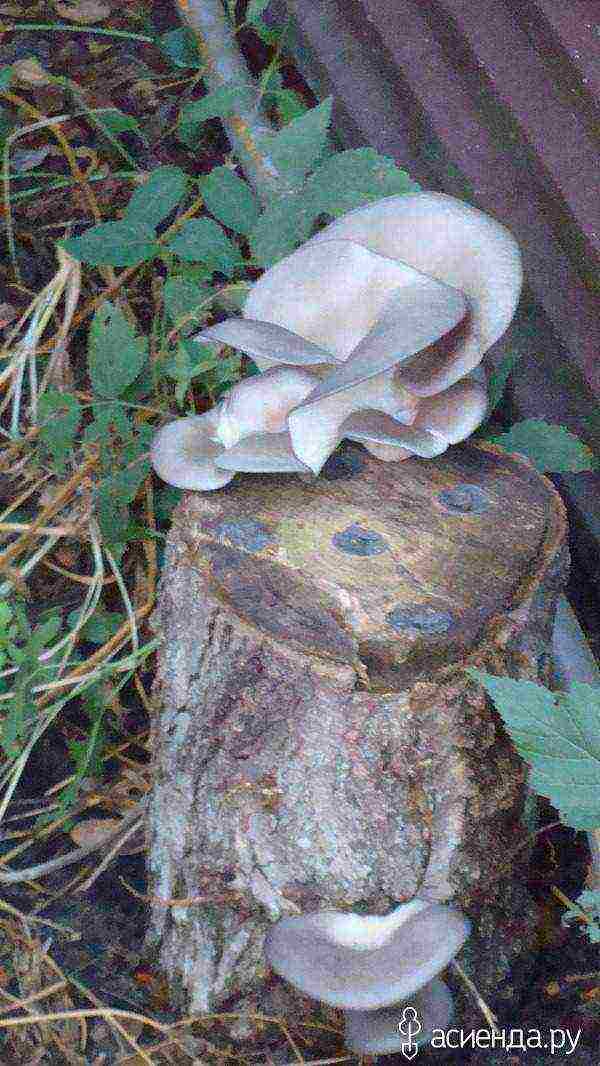
It is not difficult to grow oyster mushrooms. I will tell you what conditions are necessary for this.
I harvest healthy hardwood: poplar, aspen, apple, pear, walnut. I saw it into stumps with a height of 30-40 cm and a diameter of at least 18 cm. On each one I make notes (small notches) on the cut, which was on the side of the crown. The bark does not need to be removed. Along the entire lateral surface of the stumps, I drill holes with a diameter of 10-15 mm, a depth of 7-10 cm at a distance of 12-15 cm from each other. I soak the workpieces in water in any container (bath, barrel) for 2-3 days. Fresh wood need not be soaked.
Pick-up location
In a shady, damp place of a garden plot or vegetable garden (it is possible between currant bushes, gooseberries and in a raspberry tree), I dig holes 15-20 cm deep, slightly larger in diameter than hemp. At the same time, it is important to observe the distance between the holes - 30-35 cm. At the bottom of each hoard I put moistened sawdust (or small shavings, straw) with a layer of 1-1.5 cm. On top I pour the planting mycelium of mushrooms with a layer of 1 cm and put the hemp notches up. It is very important.
Growing oyster mushrooms on stumps
The fact is that wood has the ability to absorb water only in the direction from the root to the crown. And if the stump stands incorrectly, "roots" upwards, it will not absorb water from the soil and will give a very small harvest of mushrooms (only one harvest, and in dry weather it may not be at all).
Oyster mushroom growing technology
Before putting the stumps in the hole, I fill the holes drilled in them with planting mycelium and close the outside with wax or corks from wet sawdust. Instead of holes, you can make cuts, slots and fill in the same way.
Around the stumps installed in the holes, I compact the soil - I trample it down with my feet. To save space, wooden blanks can be stacked on top of each other, matching by diameter. Each or all together I cover for 2-3 weeks with a piece of clean plastic film, which I must first perforate (pierce) through 10-15 cm with a nail.
For this purpose, you can use clean plastic bags or bags - put them on the stumps and fasten them so that they do not fly off. Such a shelter protects the mycelium and wood from drying out and promotes better survival of the planting mycelium.
Oyster mushroom growing on a tree stump
How to care for oyster mushrooms?
In this way, I plant the oyster mushroom in May - early June, so that during the warm summer time the mycelium grows well in the wood. Care consists in keeping the soil around the stumps moist. If weather conditions are favorable, fruiting begins in September-October of the current year. When using high-quality mycelium and certain strains (varieties), I harvest oyster mushrooms annually from April to November for 4-5 years, depending on the density of the wood and the diameter of the stumps.
As you can see, it is not so difficult to grow oyster mushrooms in the country. Try it - and you will surely be able to harvest a good harvest of mushrooms.
 In nature, fungi parasitize on tree trunks. Their mycelium filaments can spread over long distances. The area of an adult mycelium ranges from 10 m2 to 15 m2, depending on the type of fungus. Oyster mushrooms are mushrooms that are unpretentious to growing conditions. Their spores infect deciduous trees. The mycelium can spread to the straw of cereals, such as wheat, as well as to sawdust of birch or oak.
In nature, fungi parasitize on tree trunks. Their mycelium filaments can spread over long distances. The area of an adult mycelium ranges from 10 m2 to 15 m2, depending on the type of fungus. Oyster mushrooms are mushrooms that are unpretentious to growing conditions. Their spores infect deciduous trees. The mycelium can spread to the straw of cereals, such as wheat, as well as to sawdust of birch or oak.
At their summer cottage, mushrooms are grown on stumps. They use firewood that was harvested a month ago. The logs are still wet and the bark can be easily removed from them, but most of the stump is already dry. Such wood is ideal for the development of mushroom mycelium.
Fungal spores can infect healthy trees in the garden. If the mycelium spreads to fruit trees, their yield will be significantly reduced, and three to four years after infection, the tree will die. Therefore, stumps with mushroom spores are placed away from the garden in a shaded place, for example, under the wall of a house.
Stump preparation
To grow mushrooms, you need to prepare the wood.Stumps with a diameter of 25 cm and a length of 50 cm are infected with spores. The stumps are sawn into three parts. Several holes are made in the first cut.
Use a nib drill. It is very difficult to drill holes with a conventional cartridge nozzle, since the wood is still wet. The depth of the holes must be at least 5 cm.
On the other side of the saw cut with a circular or gasoline saw, make several longitudinal and transverse cuts of the same depth. You will get a kind of mesh. Nails are hammered along the diameter of the logs, the caps of which are removed with nippers. Then they do a few simple steps:
- the first part of the log is filled with mycelium;
- then it is placed in the prepared hole with the holes down;
- a layer of mycelium is applied to the first part of the log;
- cover with the second part of the stump;
- another layer of mycelium is applied;
- cover with the last part of the stump.
The joints of the logs are wrapped with tape to protect the mycelium from ants. In order for the spores to germinate and give a fruiting body, the stumps infected with mycelium are placed in a shaded place on the site. After two months, you can harvest oyster mushrooms, provided that the logs are constantly moistened. They are watered every week.
Set up drip irrigation for stumps. Then the stumps do not have to be monitored until the harvest. Use a feather drill to make a groove in the third part of the log for the diameter of the neck of the plastic bottle. Cut off the bottom of the bottle, place it in the recess and fill with water.
